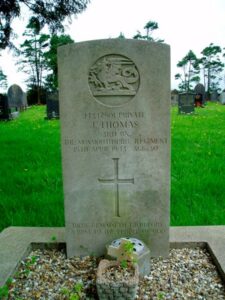Llanybri is a small village which is situated roughly two miles north of Llansteffan, on the road to Bancyfelin. In recent years two new war memorials have been erected on the tower of the ruined Hen Gapel, which lies at the centre of the village. Included amongst the names on these two plaques are three men who are also commemorated at Capel Newydd. All of the fallen are also commemorated at nearby Llansteffan.
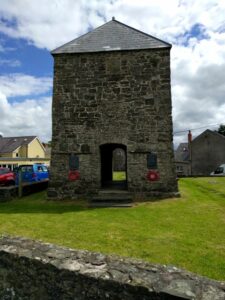
The Great War, 1914-1918
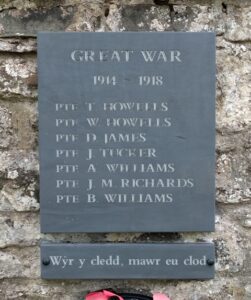
Thomas Howells, Private, M2/046283, Royal Army Service Corps. Thomas was born at Llanybri, the son of John and Mary Howells. The family then moved to Llain, at Llanybri, where Thomas grew up, and his brother William was born. Thomas enlisted at Merthyr into the Army Service Corps, Base Mechanical Transport Depot. John was sent to France in 1915, but took ill and Died of Sickness on 19 January, 1916, aged 36. He is buried in Ste. Marie Cemetery, Le Havre, France. Many thanks to Andrew Devine, the Great Nephew of Thomas, for the photograph of him in uniform.
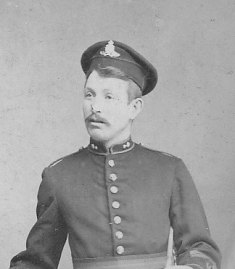
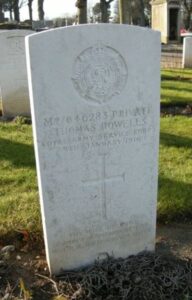
William Howells, Private, 54571, Welsh Regiment. William was the younger brother of Thomas, the son of John and Mary Howells. William had been born at Star House, Llanybri, and enlisted at Carmarthen into the Pembroke Yeomanry. Later William transferred into the 9th Battalion, the Welsh Regiment, which formed part of 58 Brigade, 19th (Western) Division. It is not known when William transferred, but the 19th Division had fought in all of the major battles of the War, at Loos, the Somme and at Passchendaele, and were to meet their sternest tests in 1918. They were in the St. Quentin area when the German Spring Offensive was launched, before moving North to Messines, where they suffered terrible losses. William was wounded at Messines, and was evacuated to the Casualty Clearing Station at Haringhe, West of Ypres, where William Died of Wounds on 15 April 1918, aged 27. He is buried there, in Haringhe (Bandaghem) Military Cemetery, Belgium.
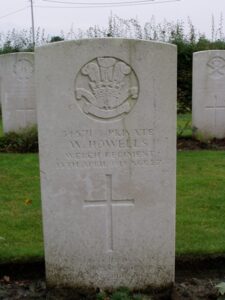
David James, Sergeant, 448350, Royal Engineers. David was born at Llanybri on 19 October 1884, the son of Thomas and Hannah James. He moved to the Smithy, Llanddowror in 1908, and married Martha Thomas, of St. Clears in 1910. David joined the 2/1st Welsh Field Company, Royal Engineers on 14 November 1914, and was promoted Farrier Sergeant on 27 September 1915. He was sent to the Dardanelles in October 1915 and from there was transferred to Egypt in December that year, when he was transferred to the 437th Field Company. He marched with the Forces from Egypt to Palestine and was present at the Battle of Gaza and other engagements. David was due to return to England in November 1917, and was returning firstly to Palestine on the Aragon when the ship was torpedoed by a submarine on 30 December 1917 and he was drowned, aged 33. David is remembered on the Alexandria (Chatby) Memorial, Egypt. He is also commemorated on war memorials at Llansteffan and at Llanddowror.
James Meredith Richards, Private, 16609, West Riding Regiment. James was the son of James L. Richards and Ada Janet Richards, of Pantyrathro, Carmarthen. He was educated at Llandovery from 1911 to 1912, and then was in business in London. In September 1914 James enlisted in the Army at Cardiff, and joined the Dragoon Guards, but was invalided home with a leg wound, and spent some time in Hospital at Manchester. On recovering from his wound, James transferred Regiments, joining the 2nd Battalion, Duke of Wellington’s (West Riding) Regiment. The Battalion was attached to 12 Brigade, 4th Division, and by the time James joined them in July 1916, they were in positions on the Somme, where they fought at the Battle of Albert and the Battle of Le Transloy. On 15 December 1916 the Battalion relieved the Essex Regiment in the front line at Bapaume, in atrocious weather conditions. It is believed that James was killed by a sniper there, on 19 December 1916. He was 22 years old, and is buried at Sailly-Saillisel British Cemetery, France.
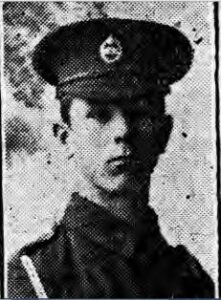
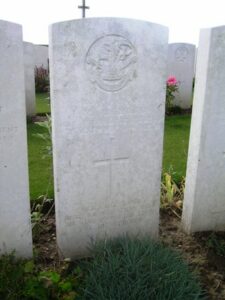
John Tucker, Private, 13406, Welsh Regiment. John was born in Llanybri in 1890. He was raised by his Grandparents Thomas and Martha Tucker at Church Cottage, Llanybri, and lived with his sister, Sarah George and her husband, at 19, Lady Street, Kidwelly prior to 1911. John enlisted at Kidwelly into the 9th Battalion, Welsh Regiment, which was attached to 58 Brigade, 19th (Western) Division. The Division assembled around Bulford during September 1914. Divisional training was completed near Tidworth, and the Division moved to France during July 1915, taking up positions near Givenchy, north of Loos. The Division fought during the opening attack of the Battle of Loos, which is where John was killed in action on 25 September 1915, alongside his friend Morgan Morgan of Kidwelly. John is buried at Brown’s Road Military Cemetery, Festubert, France.
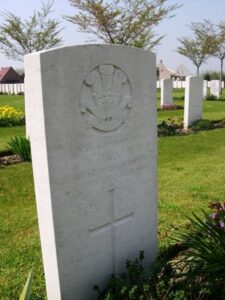
Arthur Williams, Private, 55462, Royal Welsh Fusiliers. Arthur was born at Llanybri and worked as a farm labourer at Pentowin, Llansteffan prior to the war. He enlisted into the Royal Welsh Fusiliers and landed in France at some time in 1916, joining the 16th Battalion, Royal Welsh Fusiliers, which was attached to 113 Brigade, 38th (Welsh) Division. The Division had been in France since December 1915 and remained there throughout the war, fighting at Armentieres, before being moved South to the Somme, being ordered to capture Mametz Wood. The Division were badly cut up at Mametz, and were pulled out of the line, not being used again for nearly a year, when they took part in the Battle of Pilckem Ridge, part of the larger Passchendaele Offensive. After Passchendaele, they moved South again, to help try and stem the German Spring Offensive, and when the tide had turned the way of the Allies in August 1918, the Division played a major part in the advance that followed to the Hindenburg Lone and beyond. On 8 October 1918 the Division captured Villers-Outreaux, part of the 1918 Battle of Cambrai, and Arthur was killed in action that same day, aged only 21. He is buried at Bois-Des-Angles British Cemetery, Crevecouer-Sur-L’Escaut, France.
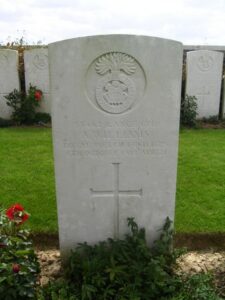
Benjamin Williams, Private, 8001, Welsh Regiment. Benjamin was the son of Thomas and Anna Williams, of Penybank, Llanybri. He enlisted at Cardiff several years prior to the war into the 2nd Battalion, Welsh Regiment. The battalion was stationed at Pembroke Dock at the outbreak of war, and moved to France with 3 Brigade, 1st Division. They fought in the opening Battle of Mons, before fighting a retreat South towards the Aisne, where they stopped the German Advance. They moved North again, to La Bassee, then to Ypres, where they withstood the heavy German assault on the ancient fortified City in the Battle of First Ypres. Benjamin had been wounded at the Battle of La Bassée, and was taken to the Duchess of Westminster’s Hospital (No.1 B.R.C.S) at Le Touquet where he died of wounds on 30 January 1915, aged 36. He is buried at Le Touquet-Paris Plage Communal Cemetery, France.
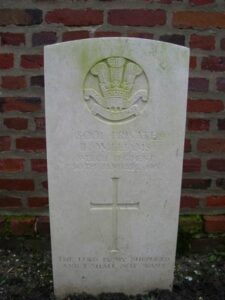
World War Two, 1939-1945
Phillip Thomas Davies, Sergeant, 1152952, Royal Air Force Volunteer Reserve. Phillip was the son of Sydney Arthur Davies and Gwladys Davies, of Llanybri, and enlisted into the R.A.F.V.R., joining 166 Squadron. The Squadron was based at R.A.F. Kirmington from 27 January 1943, operating first Whitley’s, then Wellington’s and Lancaster Bombers. Phillip was one of the crew of Wellington Mk X, Serial LN397 when the aircraft was shot down on a bombing raid on Monchengladbach on 31 August 1943. He is remembered on the Runnymede Memorial, Surrey. He was just 20 years old. There is a memorial to him on his parents grave at Llanybri Churchyard.
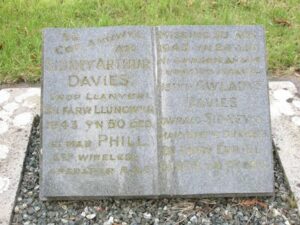
Ivor Lewis Evans, Private, 14541568, Cheshire Regiment. Ivor was born in the Llansteffan area, and served in the 6th Battalion, the Cheshire Regiment, which was created from a doubling up of the Territorial Army at the outbreak of WW2. The 6th Battalion was part of the 56th Division, who were moved from North Africa to take part in the Italian Campaign. On 3 September 1943, the Allies invaded the Italian mainland. Following the fall of Rome to the Allies in June 1944, the German retreat became ordered and successive stands were made on a series of defensive lines. In the northern Appenine mountains the last of these, the Gothic Line, was breached by the Allies during the Autumn campaign and the front inched forward as far as Ravenna in the Adratic sector, but with divisions transferred to support the new offensive in France, and the Germans dug in to a number of key defensive positions, the advance stalled as winter set in. Coriano Ridge was the last important ridge in the way of the Allied advance in the Adriatic sector in the autumn of 1944. Its capture was the key to Rimini and eventually to the River Po. German parachute and panzer troops, aided by bad weather, resisted all attacks on their positions between 4 and 12 September 1944. On the night of 12 September the Eighth Army reopened its attack on the Ridge, with the 1st British and 5th Canadian Armoured Divisions. This attack was successful in taking the Ridge, but marked the beginning of a week of the heaviest fighting experienced since Cassino in May, with daily losses for the Eighth Army of some 150 killed. Ivor was Killed in Action at Coriano Ridge on 18 September 1944, aged just 21. He is buried in Coriano Ridge War Cemetery, Italy.
Thomas Lloyd, Sergeant, Home Guard. Thomas was the son of Jane Lloyd, and the husband of Hannah Mary Lloyd, of Llangain. Being too old for overseas service, he served at home in the 1st (Carmarthenshire) Battalion, the Home Guard, and Died at home, aged 45, on 22 July 1941. He is buried at Llangynog Churchyard.
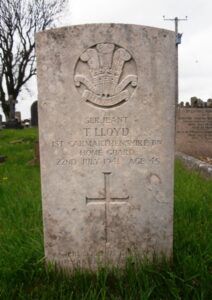
William John Rogers, Gunner, 1747903, Royal Artillery. William was born at Llanybri, the son of John and Margaret Rogers, and the husband of Sarah Mary Rogers, of Llanybri. He joined the Royal Artillery at the outbreak of War, serving in their 313th Battery, 4th Heavy Anti Aircraft Regiment. William was possibly serving as an Anti Aircraft Gunner aboard a ship, as he was killed on 30 October 1942, aged 35, and is remembered on the Brookwood Memorial, Surrey. He was probably serving aboard the Boom defence vessel Panorama. The Brookwood Memorial serves to commemorate members of the UK land forces who died in WW2 and who have no known graves. The majority of the names on the memorial are of people lost at sea, while the others are those whose burial locations are not known.
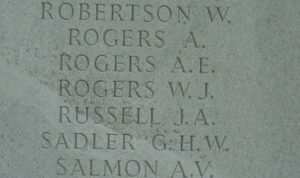
John Thomas, Private, 14342801, Monmouthshire Regiment. John was the Husband of Annie Florence Thomas, of Llanybri. He served in the 3rd Battalion the Monmouthshire Regiment, which was a Territorial Unit, mobilised as part of the 53rd (Welsh) Division in Northern Ireland. It trained in Northern Ireland in 1940 and returned to England in 1941. In the summer of 1942 it was transferred to the 11th Armoured Division and trained for armoured warfare. The Division were to embark for North Africa, but this was cancelled, and they instead landed in Normandy on 14 June, 1944. John didn’t get to France though, as he Died at home on 15 April 1943, aged 30. He is buried in Llanybri Churchyard.
